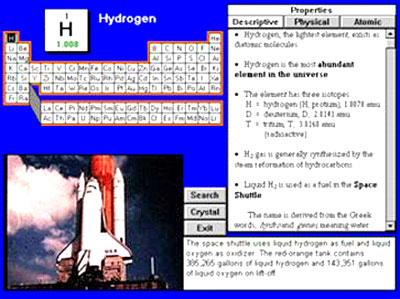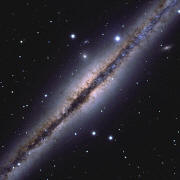|

by William Hamilton III
from
AstroSciences Website
Introduction:

The prevailing theory called the Big
Bang presumes the creation of the entire universe from ex nihilo,
that is, "creation out of nothing”. A more formal statement by
cosmologist is that the universe resulted from a vacuum fluctuation.
There was no space, no time and no matter, yet we are led to believe
that from this state of no-thing a special event occurred over 15
billion years ago. Though the Big Bang has become the prevailing
paradigm, a challenge to its role as a dominant theory of the
universe has been made and is known as the Quasi Steady State
Cosmology (QSSC) proposed by scientists Fred Hoyle,
Geoffrey Burbridge, and Jayant V. Narlikar.
The QSSC proposes the continuous creation of matter in space rather
than a single event and proposes to account for observations that
seem to strain the limits of the Big Bang model. Other proposed
cosmologies suggest that our universe is just one in a chain of
reproducing universes. That the substance of the universe seems to
come from nowhere is a continuing mystery and is the edge where
physics fumbles for answers.
Some recent correspondence hints that anomalous appearances and
disappearances of matter have taken place without accountability. If
verified, this could put a whole new spin on the creation process
and suggest that either matter and energy can be created or there is
a bridge to some other physical dimension that permits the transfer
of matter and energy into our universe. This also bumps up against
the edge of another mystery, the mystery and role of consciousness
in the universe.
Matter
creation:
According to Narlikar,
“The action principle tells us that
matter creation is possible at a given spacetime point provided
the ambient c-field satisfies the equality c=mp at that point.
In normal circumstances, the background level of the c-field
will be below this level. However, in the strong gravity
obtaining in the neighborhood of compact massive objects the
value of the field can be locally raised. This leads to creation
of matter along with the creation of negative c-field energy.
The latter also has negative stresses which have the effect of
blowing the spacetime outwards (as in an inflationary model)
with the result that the created matter is thrown out in an
explosion. We shall refer to such pockets of creation as
minibangs or mini-creation events.”
(01)
In email exchanges physicist Robert Neil
Boyd noted an anomalous phenomena in a vacuum chamber.
“That was our first thought, that
the hydrogen was migrating through the walls of the containment
chamber. But we were rapidly disabused of this notion by the
sheer volume and persistence of the hydrogen density.
Regardless of how many times we ionized the chamber and swept
the chamber clean, we still had the same amount of hydrogen we
started with. And we could count how much hydrogen we had
removed from the chamber. So it was obvious what was going on.
Hydrogen was being created in the chamber. Our observations
informed us that this process did not occur until a certain
level of vacuum had been obtained. But from then on, it was
hopeless to try to obtain our “perfect vacuum”. So we gave up
and worked with what we had to work with.
• Perhaps it slips in some where
your not able to detect, via
• the “pulling in” of multiple “sub atomic” substructures
and it
• then “builds” on top of that which “collects” within the
chamber.
Maybe. But it is appearing there in
the vacuum chamber. I still can’t account for the sheer volume
of it by such logical excursions as the above mentioned
possibility. For us, the process was similar to trying to empty
out a flowing stream of water by using a spoon. We kept taking
water out, and more kept appearing. It doesn’t take too long
under such circumstances to realize that the effort is futile.
• Until you confirm that
absolutely no such things are happening, we
• can’t assume it has formed/created via the “ether” within
• the “chamber”
Your suggestion could be the answer.
I don’t know. All I know right now is we couldn’t get rid of it
as fast as it appeared in the chamber, when we reached a certain
level of vacuum.
• Thus, I would not assume it
has been created/formed from ether
• directly within the chamber.
A fair
assumption. Is it testable?”
How does a universal ether of
subquantic particles give rise to a structure such as Hydrogen? It
is believed that virtual elementary particles are constantly created
and destroyed in a continuous flux out of the vacuum, but Hydrogen
is already an assembly of particles. Extreme vacuums exist in space
where molecular Hydrogen also exists in abundance.
Answers to queries:
Neil,
I have forwarded you statements on Hydrogen left in the
containment vessel to a biological scientist who has discovered
something amazing and he asked these questions which you may or
may not be able to answer.
The link he gives is most
interesting...
“Yes, the degree of vacuum is
important and yes these results could be supportive (if not
confirmatory) of a source, external to our Universe’s
explicate matter. Yes, I am very interested in hearing more
of it. Just being tantalized by the information you sent, I
have a few questions/ideas to banter around.
Q1. Was the hydrogen obtained “normal” diatomic or in
an ionized state? It sounds like diatomic gas but I assume
nothing anymore.
Ans: Due to the methods we used, i.e., electrical
discharges through the chamber, most of the hydrogen we got
was in an initially ionized condition, later turning
monatomic, then diatomic as it was collected, stored, and
transported away from the fusion confinement volume.
Q2. Under the assumption
that it was diatomic hydrogen, and knowing the utter
frustrations involved with being unable to eliminate
intervening variables, I wonder.... With the use of Faraday’s
Law we can induce a magnetic moment, thereby force-exposing
any diatomic hydrogen (usually only weakly magnetic),
external to the test vessel, to a magnetic field, draw it
away, and at least substantially eliminate the influx
variable -- (where “it slips in some where you are not able
to detect”) can be thrown out??
Ans: Yeah, we did that, in addition to ionizing
whatever gases were in the chamber. We referred to that
process as "sweeping the chamber". That was where the
mystery started.
Q3. In the spirit of work
that was conducted and reflected at this
site---http://www.globaltechnoscan.com/31stOct-6thNov01/vacuum_charted.htm
Ans: Regarding this above article, it has been known
for several years that Photons interact with each other.
This Swedish experiment seems to produce some confirmation
of Louis de Broglie’s original hypothesis concerning the
existence of a material subquantum media with which the
waves interact, and depend on. Einstein’s early expression,
that there was no reason to postulate an aether wave media
in his physics paradigm, apparently discouraged subsequent
researches in this direction, in spite of the fact that
Einstein later recanted his stance on the non-existence of
an aether, saying that we actually required one.
Q4. Would there be a way
to (or did the original researchers already conduct) an
internal measurement of electromagnetic field changes or
emissions (if any) over time as this phenomenon proceeded?”
Ans: Standard plasma diagnostics techniques are
pretty accurate in
these regards. But the instrumentation and other equipment
required
are most likely not something your average garage hobbyist
will be
able to afford
Paul Marmet explains,
(2)
“ In papers published about a decade
ago, the author and colleagues predicted the widespread presence
of hydrogen in the molecular (H2) form in space (Marmet
and Reber 1989;
Marmet 1990a,b). Although
hydrogen in the atomic form is easily detected through
radioastronomy, the molecular form is difficult to detect. We
showed that the presence of this missing mass would explain the
anomalous rotational motion observed in galaxies, which is
otherwise explained by exotic hypotheses, such as swarms of
invisible brown or white dwarfs, or weird atomic particles
called WIMPs or axions, and "quark nuggets."
We also showed that the presence of large amounts of the
hard-to-detect molecular hydrogen in interstellar space could
provide an alternative explanation to the Big Bang theory, by
explaining the observed redshift as a result of the delayed
propagation of light through space, caused by the collision of
photons with interstellar matter.
The more commonly held view explains the observed shift in
frequency of the spectral lines detected from distant galaxies
as arising from a Doppler shift (a shift in the frequency of a
wave caused by the relative motion of the emitting object and
the observer). The downshift in the frequency, toward the red
end of the spectrum, is taken to mean that distant galaxies are
receding from us, thus implying an expanding universe.
Our prediction, based on a critique of many of the commonly held
assumptions of cosmology, was the result of a serious study of
the molecular structure of hydrogen and of the astronomical
observation of atomic hydrogen in space. However, the
astrophysicists preferred to ignore H2, and instead to
hypothesize the existence of weird objects.”
Could H2 be assembling in space by the
creation process? This would throw a whole new light on our
universe.
Marmet goes on to say,
 “Using
the European Space Agency's Infrared Space Observatory,
E. A. Valentijn and P. P. van der Werf recently detected huge amounts
of molecular hydrogen (H2) in
NGC 891
(click image right), an edge-on galaxy 30 million
light-years away in Andromeda (Valentijn and van der Werf 1999).
In their report, published in September 1999, they state that
their result "matches well, the mass required to solve the
problem of the missing mass of spiral galaxies." “Using
the European Space Agency's Infrared Space Observatory,
E. A. Valentijn and P. P. van der Werf recently detected huge amounts
of molecular hydrogen (H2) in
NGC 891
(click image right), an edge-on galaxy 30 million
light-years away in Andromeda (Valentijn and van der Werf 1999).
In their report, published in September 1999, they state that
their result "matches well, the mass required to solve the
problem of the missing mass of spiral galaxies."
They conclude that the galaxy contains 5
to 15 times more molecular than atomic hydrogen. [For a second
Internet news story on this discovery
click here.]
It is generally accepted that atomic hydrogen is by far the most
abundant particle in the universe. It is also well established that
about 10 times as much molecular hydrogen as atomic hydrogen solves
the missing mass problem. Finally, Valentijn adds:
"The halo culture that has grown up
around the dark matter problem might never have arisen if the
ISO results had been known earlier."
Two months after the publication of
this discovery, in a piece published in Nature, Nov. 25, 1999,
P. Richter, et al. reported the discovery of the absorption
lines of molecular hydrogen in a high-velocity cloud of the
Milky Way halo (Richter et al. 1999).”
In 1997 scientists created matter from
light.
“A team of 20 physicists from four institutions has
created
particles of matter from ordinary light for the first time. The
experiment was carried out at the Stanford Linear Accelerator Center
(SLAC) by scientists and students from the University of Rochester,
Princeton University, the University of Tennessee, and Stanford. The
team reported the work in the 1 September issue of Physical Review
Letters.
(03)
The implications of a creation process are such that we might
envision a future science where we make matter to order by
replicating the universe’s creation process.
Since we know that consciousness plays a significant role in quantum
processes, could it be possible for us to create matter
out of the
void using our minds alone? The ancients believed that it was not
matter that produced mind, but mind that produced matter.
References:
(01)
http://www.iisc.ernet.in/pramana/dec1999/c3.pdf
(02)
http://www.newtonphysics.on.ca/hydrogen/
(03)
http://www.spie.org/web/oer/november/nov97/briefly.html
|

